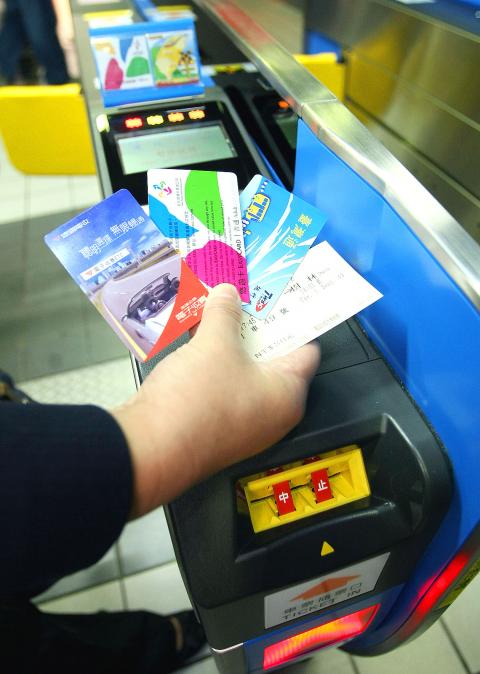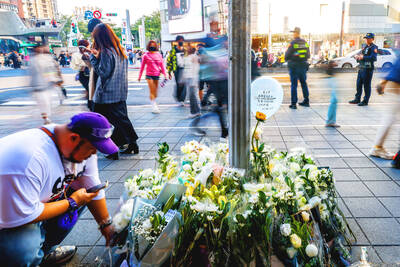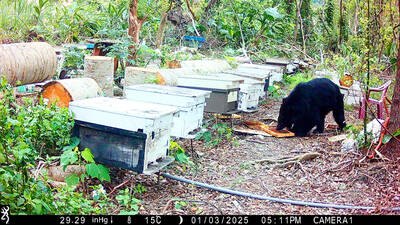The Taiwan Railway Administration (TRA) yesterday activated multiple card-reading ticket gates at the Taipei, Songshan and Nangang train stations, in a first step toward integrating the various electronic cards used across the nation.
TRA Director-General Frank Fan (范植谷) said new ticket gates would be activated at other train stations between Keelung and Hsinchu by the end of the year.
Passengers can now use both the EasyCard and the Taiwan EasyGo Card to board TRA trains.

PHOTO: CNA
The TRA began allowing passengers to board trains using the EasyCard in 2008. It later began accepting the Taiwan EasyGo Card, although this required the installation of separate card readers.
By the end of the year, the new gates would also allow passengers to use freeway electronic toll-collecting cards and the Kaohsiung MRT’s I-Pass, which is issued by the Kaohsiung City Government.
Minister of Transportation and Communications Mao Chi-kuo (毛治國) told an inauguration ceremony that the TRA was the first public transportation system in Taiwan to use multiple-card reading ticket -machines, adding that he hoped passengers would eventually be able to use different electronic cards to use the various public transportation systems nationwide.
Currently, EasyCards are used on the Taipei MRT system, while the Taiwan EasyGo Card, issued by Taiwan Smart Card Corp, is used on public buses in areas between Taoyuan and Changhua. Bus systems in counties south of Chiayi use the Taiwan MoneyCard.
While 8,000 daily passengers had initially boarded trains using electronic cards, that number had risen to 130,000 within two years.
Du Wei (杜微), deputy chief of the TRA’s transportation department, said an average of 240,000 passengers travel between Keelung and Hsinchu every day, about half of whom use electronic cards.
The TRA said the new ticketing gates allowed a maximum of 60 passengers to pass through per minute.
Before the multiple-card reading ticket gates become widely available, Du said passengers using EasyCards could only board trains operating between Keelung and Jhongli (中壢) in Taoyuan County. People using the Taiwan EasyGo Card, meanwhile, can only board trains running between Rueifang (瑞芳) in Taipei County and Hsinchu.
Meanwhile, the Ministry of Transportation and Communications has launched a three-year plan to offer subsidies of as much as 49 percent of costs for operators to install multicard reading ticket machines, provided that the installation is completed within three months.
About 6,800 public transit buses in Taipei, Keelung, Taichung, Chang-hua and Nantou are expected to benefit from the policy.

HORROR STORIES: One victim recounted not realizing they had been stabbed and seeing people bleeding, while another recalled breaking down in tears after fleeing A man on Friday died after he tried to fight the knife-wielding suspect who went on a stabbing spree near two of Taipei’s busiest metro stations, Taipei Mayor Chiang Wan-an (蔣萬安) said. The 57-year-old man, identified by his family name, Yu (余), encountered the suspect at Exit M7 of Taipei Main Station and immediately tried to stop him, but was fatally wounded and later died, Chiang said, calling the incident “heartbreaking.” Yu’s family would receive at least NT$5 million (US$158,584) in compensation through the Taipei Rapid Transit Corp’s (TRTC) insurance coverage, he said after convening an emergency security response meeting yesterday morning. National

Taiwan has overtaken South Korea this year in per capita income for the first time in 23 years, IMF data showed. Per capita income is a nation’s GDP divided by the total population, used to compare average wealth levels across countries. Taiwan also beat Japan this year on per capita income, after surpassing it for the first time last year, US magazine Newsweek reported yesterday. Across Asia, Taiwan ranked fourth for per capita income at US$37,827 this year due to sustained economic growth, the report said. In the top three spots were Singapore, Macau and Hong Kong, it said. South

PLANNED: The suspect visited the crime scene before the killings, seeking information on how to access the roof, and had extensively researched a 2014 stabbing incident The suspect in a stabbing attack that killed three people and injured 11 in Taipei on Friday had planned the assault and set fires at other locations earlier in the day, law enforcement officials said yesterday. National Police Agency (NPA) Director-General Chang Jung-hsin (張榮興) said the suspect, a 27-year-old man named Chang Wen (張文), began the attacks at 3:40pm, first setting off smoke bombs on a road, damaging cars and motorbikes. Earlier, Chang Wen set fire to a rental room where he was staying on Gongyuan Road in Zhongzheng District (中正), Chang Jung-hsin said. The suspect later threw smoke grenades near two exits

The Forestry and Nature Conservation Agency yesterday launched a gift box to market honey “certified by a Formosan black bear” in appreciation of a beekeeper’s amicable interaction with a honey-thieving bear. Beekeeper Chih Ming-chen (池明鎮) in January inspected his bee farm in Hualien County’s Jhuosi Township (卓溪) and found that more than 20 beehives had been destroyed and many hives were eaten, with bear droppings and paw prints near the destroyed hives, the agency said. Chih returned to the farm to move the remaining beehives away that evening when he encountered a Formosan black bear only 20m away, the agency said. The bear